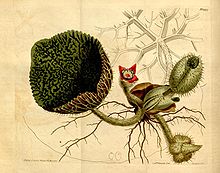Euryalaceae
| Euryale ferox | |
|---|---|
 |
|
| Illustration of Euryale ferox from Curtis's Botanical Magazine (1812). | |
| Scientific classification | |
| Kingdom: | Plantae |
| Clade: | Angiosperms |
| Order: | Nymphaeales |
| Family: | Nymphaeaceae |
| Genus: |
Euryale Salisb. |
| Species: | E. ferox |
| Binomial name | |
|
Euryale ferox Salisb. |
|
Euryale ferox (also known fox nut, foxnut, gorgon nut, makhana, makhana in Hindi and Punjabi, thangjing in Meitei, nikori in Assamese, onibasu in Japanese, gasiyeon in Korean) is the only extant species in the genus Euryale. It is a flowering plant classified in the water lily family, Nymphaeaceae, although it is occasionally regarded as a distinct family Euryalaceae. Unlike other water lilies, the pollen grains of Euryale have three nuclei.
Euryale is an perennial plant native to eastern Asia, and is found from India- found in Bihar, (local name Makhana) and in Loktak Lake Manipur (local name Thangzing) to Korea and Japan, as well as parts of eastern Russia. It grows in water, producing bright purple flowers. The leaves are large and round, often more than a meter (3 feet) across, with a leaf stalk attached in the center of the lower surface. The underside of the leaf is purplish, while the upper surface is green. The leaves have a quilted texture, although the stems, flowers, and leaves which float on the surface are covered in sharp prickles. Other leaves are submerged. In India, Euryale normally grows in ponds, wetlands etc. Recently the Indian Council of Agricultural Research have developed a technique for the field cultivation of Euryale.
It is eaten in Manipur. It is cooked along with Allium tuberosum, garlic chives, Oriental garlic, Asian chives, Chinese chives, Chinese leek, bori etc. In Manipur, E. ferox is a local delicacy.
...
Wikipedia
